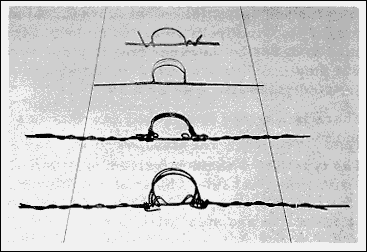Line Tie Wires
by Al Perry
Reprinted from "INSULATORS - Crown Jewels of the Wire", February 1970, page 25
Well Christmas is over and I guess I'll get back to insulators. Want
to congratulate you on the fine publication. Thought I would answer
your article on page 14 & 15 of your September 1969 issue.
The pieces of copper ribbon you found are from a type of tie that
the Telephone Co. used. I am employed by Northwestern Bell here
in Rapid City, South Dakota and have spent 4 years on the line crew, 3 years in
maintenance, and 1 year in splicing. So may not be an authority on the
ties but I'll give you a little information on them.

I am enclosing a picture of the ones I have on the front of my
insulator rack. Starting from the top is the old Horseshoe Tie.
The second is a ribbon type. It is a thin piece of flat copper about 1/4"
wise and as thick as the cover of your book. It was wrapped very close and
tight on the line wire for about 2 inches at the point where the wire came
in contact with the glass. Then the 2 ends were wrapped around the
glass and back around the line wire for about 2 inches. It required a
special tool to place it.
The third one is the type you found the parts of. It consisted of a
factory formed copper steel splint placed at the point of contact of
the line wire so that the eyes fell one on each side of the glass.
Then the copper tie was placed around the glass and wrapped on
the splint approximately two turns. These could only be used on the wide
grooved glass as the Hemingray-42's (CD 154) or Whitall Tatum No. l's (CD
155).
The bottom one is the newer kind that was used until the last couple
of years. It was also a factory formed splint (different from three)
and a copper tie wire from 28" to 36" long. It is hard to describe
on paper how to place them. But they could only be used on the
square grooved glass like a Hemingray-42 (CD 154) or a Hemingray-17 (CD 122).
There is a newer one yet out now that is all one piece.
The type like the fourth one came in galvanized steel also for use on steel
line.
Most of the toll circuits are copper or copper steel and your
exchange or farm line are steel wire.
The purpose of the splint and tie was to keep the wire away from
the glass directly. With the change of temperature and vibration the
line wire has a tendency to break at this point. Also, the main
reason was to keep the slack or the tightness of the wire from
running down the lead 4 or 5 spans.
This was common in the use of
the horseshoe tie. In case of a sleet storm there is enough to do
besides pull slack that has run. If you have noticed, on some lines
in the Midwest there will be two poles and double arms. This is a
storm or H fixture. They are less apt to go down in a storm and
gave the linemen something to sag the wire against, as they are
guyed or anchored both ways. I have seen a mile of poles flat on
the ground and the H fixtures still standing. It also gave the men a
place to start to rebuild.
| 